Ted Piccone discusses the process of normalization between Cuba and the United States. He writes that although the outcomes of this complex process are not yet known, some telltale signs suggest a slow, uneven, but inevitable reconciliation that will benefit both countries for years to come. This piece was originally published by Cuba Posible.
Cuba and the United States are embarking simultaneously on at least three paths of normalization: one is the bilateral diplomatic détente launched on December 14, 2014, and the other two are the national processes each country is undertaking to socialize a new normal featuring new leadership in Cuba and the settlement of the long-held grievances of the Cuban diaspora. The outcomes of these complex processes are not yet known though some telltale signs suggest a slow, uneven, but inevitable reconciliation that will benefit both countries for years to come.
In the nearly two years since Presidents Raúl Castro and Barack Obama jointly announced their decision to begin to normalize relations after five decades of hostility and conflict, the two countries have established a rhythm of steady progress across multiple arenas of action. Once the blockage surrounding the jailing of the Cuban Five and Alan Gross was cleared, diplomatic relations were renewed quickly. Regular bilateral talks on migration, law enforcement, counter narcotics, environment, marine sciences, public health, and agriculture, among others, are leading to mutual agreements to further cooperation in both nations’ interests. Civil aviation and security accords have led to commercial flights jetting between multiple cities carrying thousands of new visitors. Thorny issues around property claims and human rights are on the table for the first time in decades. And the sixth round of U.S. regulatory changes announced in October 2016 loosening the longstanding embargo against Cuba, coupled with the public release of a new presidential policy directive directing how U.S. agencies are to implement the new strategy of U.S.-Cuba normalization, are further evidence that President Obama is determined to do all he can to leave a lasting legacy before he leaves office on January 20, 2017.
Beyond the official normalization process at the state-to-state level, the rapprochement launched on December 17, 2014 unleashed an even more important if less tangible dimension of normalization ―a psychological transformation that has shifted fundamentally the way key actors on both sides of the Florida Straits see each other. W e know from various surveys that public opinion in the United States, including among Cuban Americans, is highly positive about the change in policy.1 Business communities, especially in the travel, construction, agriculture, energy and health sectors, are eager to explore new opportunities on the island. Scientists, academics, artists, environmentalists, lawyers, and other professionals are meeting to exchange information and learn from each other, although progress is slow.
Most importantly, Cuban families living in the United States are asking themselves hard questions about how best to support their loved ones back home. Many are choosing the path of dialogue and reconciliation instead of maintaining the punishing embargo. Others, however, remain adamantly opposed to any process of normalization that does not first require the removal of the Castros from power, the establishment of free and fair elections and respect for other political rights, and the resolution of property claims, all of which are conditions under current law for lifting the U.S. embargo against Cuba. Regardless of who wins the U.S. elections in November, Congress is unlikely to lift the embargo in the short term, assuming there is only modest economic or political change on the island. Nonetheless, the overall mood has changed demonstrably toward engagement, opening new doors for resolving the historic problem of how two sovereign neighbors locked in a long dysfunctional relationship can get along with each other.
So as we look back on the last 22 months and compare it to the many years of frozen relations before then, it’s fair to say that we are in the midst of a sea change that, barring some unexpected and unlikely event that derails the process, will irrevocably alter our two countries’ relationship. A snapshot of any one day in this unfolding drama does not capture the breadth of change that is taking place, seen and unseen. At the heart of it, the leaders of our two countries have decided to stop defining each other as the enemy (even as hardliners on both sides continue to revert to type). As the presidential policy directive (PPD-43) released on October 14, 2016 states, “we are not seeking to impose regime change on Cuba; we are instead…respecting that it is up to the Cuban people to make their own choices about their future.” This alone should liberate both sides from the shackles of hostilities that nearly led to nuclear war but increasingly proved unrealistic, anachronistic, and almost tragi-comic. It allows both countries to move toward a new and better playing field of respect and cooperation.
At the same time, however, the work of untangling the damage caused by this historic confrontation has many, many miles to go, and the road is full of potholes and detours. It will take sustained political leadership and support from key constituencies in both countries to advance. It will also require a sophisticated strategy on both sides to defend the gains already made against spoilers within both societies and by those in the wider geopolitical space who may have plans of their own to disrupt the process of normalization. Among the various scenarios that could set back the process are major disruptions to the reform process in Cuba, a migration crisis, or a tightening of the embargo. I will briefly turn to each of these potential obstacles before offering conclusions on next steps.
MANAGING REFORM IN CUBA
When Raúl Castro initiated a series of important socioeconomic reforms over seven years ago, expectations were raised on the island and in the international community that Cuba would embark on the path chosen by other closed socialist regimes of liberalizing the economy along market-oriented lines. Back in 2012, after my first visit to Cuba, I hypothesized that the Castro government was serious about moving the Cuban people from wholesale dependence on the state to a new era of individual responsibility and citizenship, but that it would move in that direction gradually (“sin prisa, sin pausa” as President Castro has said). After adopting several measures to expand the private sector in certain limited categories, open idler land to farmers and cooperatives, allow businesses to hire employees and sell some goods and services directly to state-owned enterprises, progress has slowed to almost a crawl and in some areas has reversed (e.g., price controls for some commodities). President Castro reported in April 2016 that only 21 percent of the 313 reforms adopted in 2011 (Lineamentos) were completed. Turmoil in its closest ally, Venezuela, has led to cuts in subsidized oil supplies and electricity output. The tourist economy is expanding, to the benefit of important sectors of Cuba’s population (including military-run and other state enterprises), but this also puts pressure on protecting adequate food supplies at reasonable cost.2 The highly-touted campaign for foreign direct investment, including the newly developed Mariel port zone, has yielded little in the way of actual project approvals or building activities, despite the strong international interest in Cuba’s potential. Other promised reforms, like eliminating the distortionary dual-exchange rate, remain unfinished business.
Momentum in the reform process has stalled in other areas as well. Earlier commitments to intensify popular consultations to reassure citizens of slow but steady change were dropped this year when the 7th Communist Party Congress gathered to adopt an updated plan of economic restructuring; the failure to preview the plans even with party cohorts led to public criticism. Also dropped were pledged reforms to the electoral code that would have offered, if only marginally, a bit more competition in the selection of candidates to local offices. Delegates elected only a handful of new members to the Party’s Central Committee and Politburo. Internet access is moving ahead at a crawl for fear of losing control of the flow of information around the island and hampering business activity. Harassment and detention of dissidents marching peacefully to express their views actually worsened in 2016. And groups working within the system to introduce new ideas and constructive proposals for modernizing Cuba’s socialism continue to operate in a dubious grey zone, at risk of bureaucratic disruption or arbitrary closure.
These developments, of course, did not occur in a vacuum. The triple stages of transition currently underway in Cuba – economic modernization, preparation for the post-Castro era, and normalization of relations with its historic enemy, the United States – are interdependent and, done right (and with some luck) could be mutually reinforcing of positive change on the island. But it looks increasingly like reticent Cuban officials are missing some important opportunities to use the legitimacy of the Cuban revolutionary leadership to lock in some gains for its national normalization process.
MIGRATION
Cuba already faces a steady and worrisome outflow of its citizens. Over 2015, for example, Cubans leaving the island to enter the United States numbered at least 46,086, an increase of 74.6 percent from 2014 (both land and sea).3 Given Cuba’s aging demographic profile, in which 31.6 percent of the population will be 60 or older by 2030, and its reliance on a shrinking pool of well-trained state personnel to earn foreign currency abroad (income from the export of services remains Cuba’s # 1 source of external revenue), it faces an unsustainable future of higher welfare costs and declining labor resources.4
There is a brighter side to the story, though one that is not as well documented. The increasing flow of people, cash, and goods among Cubans on and off the island is bringing added hard currency, expertise and entrepreneurial energy to the country. Some of these resources are going to renovate residences, expand bed and breakfast offerings, open new businesses, and update old cars. President Obama’s decision early in his first administration to remove the cap for remittances from Cuban Americans to their families on the island stimulated this flow. So too did the Cuban government’s decision in early 2013 to facilitate the travel of Cubans off the island. Much of this activity is not captured by official statistics but it’s reasonable to assume that it amounts to a net positive for the Cuban economy.
Another key factor in determining the outbound flow of Cubans, however, is the push of the faltering economy combined with the pull of U.S. residency and welfare privileges afforded only to Cubans who make it to the U.S. homeland. The fear that, as bilateral relations normalize, the United States will curtail or withdraw these privileges is catalyzing an upsurge unlike any seen in years. Even the longstanding proponents in Miami of welcoming Cubans to the United States are having second thoughts and calling for closing the loopholes that allow Cubans to return to the island after they gain residency in one year, despite their supposed status as political asylees. These latest numbers, though high, may be manageable for now. But if Cubans were to face a sudden collapse of the economy (due to the rapid loss of Venezuelan subsidies), or an overnight termination of U.S. immigration privileges without counterbalancing remedies, and flee in droves to Florida and Texas, the normalization process could hit a major roadblock. Normally, the U.S. side could manage such a crisis, though with some difficulties, as President Bill Clinton experienced during the rafter crisis. However, the strong political sentiments against immigration could cause the next administration to pull back from closer ties until such a crisis was resolved.
THE EMBARGO
While odds are long that pro-embargo factions could summon sufficient power to force a tightening of the embargo, it is unlikely that anti-embargo forces will be able to win a wholesale lifting of the embargo absent some significant changes in Cuba either. Congressional proposals to lift the embargo piecemeal, for example by allowing U.S. companies to offer credit for agricultural exports or ending the ban on U.S. tourist travel to the island, are worthy initiatives. But they are quickly blocked by Republican and Cuban American leaders who insist on tightening the embargo. High on the latter’s legislative agenda is a new prohibition on any U.S. engagement with Cuban government entities run, operated, or controlled by the Cuban security forces. Given the extent of Cuban military involvement in Cuba’s economy, this would throw a serious wet blanket on Obama’s efforts to stimulate trade and commerce with the island.
The outcome of this November’s election will have a lot to do with whether the current congressional stalemate continues. A Democratic-controlled Senate, coupled with a pro-engagement coalition of Republicans and Democrats in the House, could move some proposals forward. In any event, the next White House will likely not put as much energy into executive actions to weaken the embargo; it is also unlikely to prioritize a high-profile campaign for an unconditional lifting of the embargo by Congress.
During this next phase of normalization, eyes in Washington will be on Cuba’s actions, particularly on three issues: the handling of Raúl and Fidel Castro’s departure from power, the resolution of outstanding property claims, and the human rights conditions in the country. As we saw in the case of Myanmar, it was not until the military regime began loosening the reins of power, allowing multiparty elections and independent media, and releasing political prisoners, that the political consensus for lifting sanctions existed in Washington. The power of the Cuban diaspora (albeit waning), and continued influence of Senators Rubio, Menendez, and Cruz in particular, are likely to be the key factors that will drive the debate for weakening or lifting the embargo. The Cuban government will, no doubt, continue to insist that their system of governance and sovereignty are not up for negotiation and will resist any moves that would look like concessions for lifting the embargo. The stalemate on the embargo, therefore, is likely to continue for some time to come.
NEXT STEPS FOR NORMALIZATION
Unwinding over five decades of hostilities will take more than a few years. At stake are fundamental existential issues for key actors on both sides. For the Cuban leadership, normalization with the United States entails a reordering of its long-practiced strategy of using the United States as the scapegoat for its own troubles; certainly the United States should take some of the blame for enabling this strategy for so long. For the Cuban exile community, including important second generation leaders, letting go of their deep animosity toward the Castros for the loss of their family homes, liberties and livelihoods is painful and slow. But in both cases, change has already begun and will continue to unfold in dynamic ways, both bad and good.
The main ingredients for keeping normalization on track are suggested by the analysis above.
First, Cuba should continue moving ahead with its promised updating of its socialist model. This should include allowing the private sector and cooperatives to grow, expanding access to the internet and other information sources, promoting new leaders prepared to bring Cuba into the modern 21stcentury, allowing political competition in and outside the party, and relaxing restrictions on civil society, media, and academic and religious communities.
Second, such steps will give hope to Cuban millennials, encouraging them to stay on the island and contribute their ingenuity and skills to Cuba’s future, instead of leaving to find work elsewhere. The United States needs to expand the number of slots for legal migration to its territory and end its wet foot/dry foot policy, which is fostering illegal trafficking and risking lives at sea.
Third, both governments should continue to deepen bilateral relations in areas that are mutually beneficial, high profile, and confidence-building. Just as important, Cuban leaders in both countries need to build the human bridges that are essential for reconciliation and compromise. This means taking maximum advantage of the impressive openings that President Obama has allowed and breaking down the walls of isolation, fear, and anger that have controlled this relationship for too long. Over time, the benefits of normalization will become even more apparent to people in both countries and normalization will, indeed, become irreversible.
-
Footnotes
- Florida International University, 2016 FIU Cuba Poll: How Cuban Americans in Miami View U.S. Policies Toward Cuba, https://cri.fiu.edu/research/cuba-poll/2016-cuba-poll.pdf; other national surveys
- For a comprehensive analysis of Cuba’s economic reform policies, see Richard Feinberg, Open for Business: Building the New Cuban Economy, (Brookings Institution Press August 2016), https://www.brookings.edu/book/open-for-business/; see also “El cambio economico de Cuba en perspectiva comparada,” eds. Ted Piccone y Richard Feinberg, Brookings Latin America Initiative Report, Nov. 6, 2014, https://www.brookings.edu/es/research/el-cambio-economico-de-cuba-en-perspectiva-comparada/
- Land migrants from Cuba to the United States in fiscal year 2014 numbered 24,278; in fiscal year 2015, 43,159. Maritime interdictions of Cubans trying to reach the United States in fiscal year 2014 numbered 2,111; in fiscal year 2015, 2,927. Jens Manuel Korgstad, “Surge in Cuban immigration to U.S. continues into 2016,” Pew Research Center, August 5, 2016, http://www.pewresearch.org/fact-tank/2016/08/05/cuban-immigration-to-u-s-surges-as-relations-warm/; U.S. Coast Guard, “U.S. Coast Guard Maritime Migrant Interdictions,” January 19, 2016, http://www.uscg.mil/hq/cg5/cg531/AMIO/FlowStats/currentstats.asp.
- United Nations Population Division, Probabilistic Population Projections based on the World Population Prospects: The 2015 Revision (Population aged 60+ (both sexes combined) by country or area, and Total population (both sexes combined) by country or area)), https://esa.un.org/unpd/wpp/Download/Probabilistic/Population/.
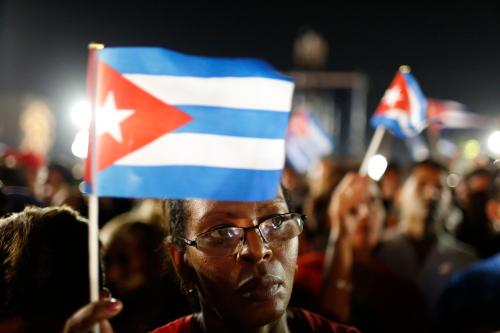
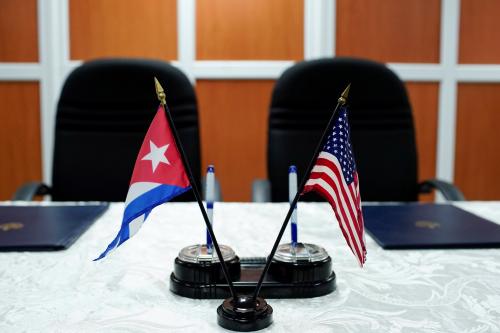
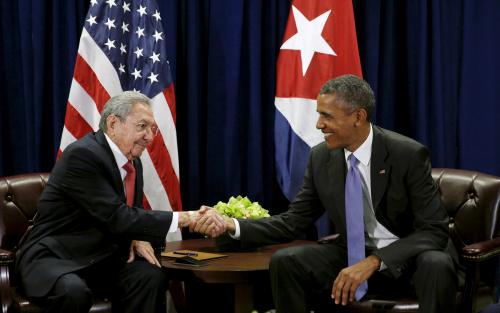
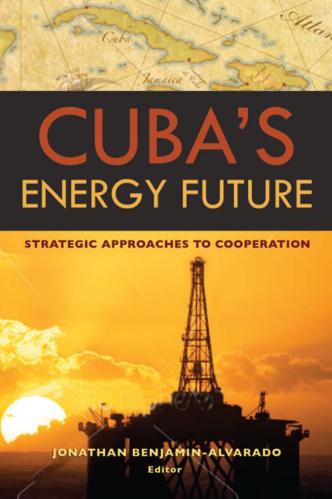
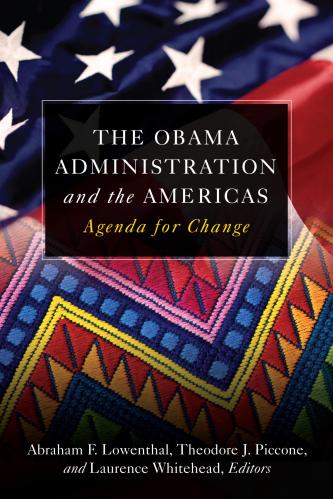
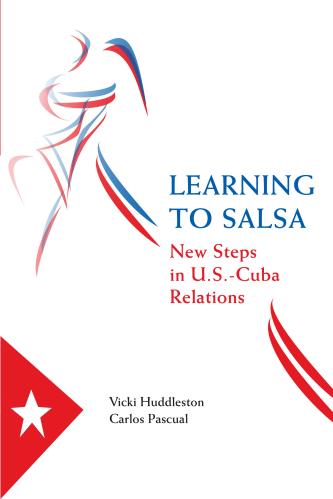
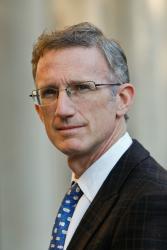

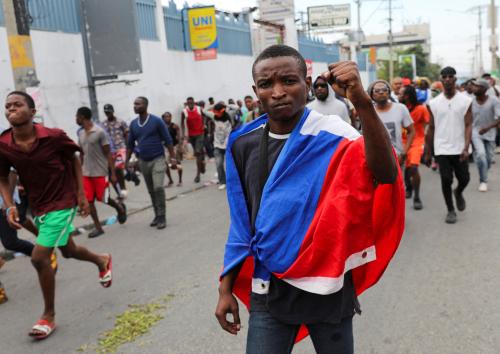
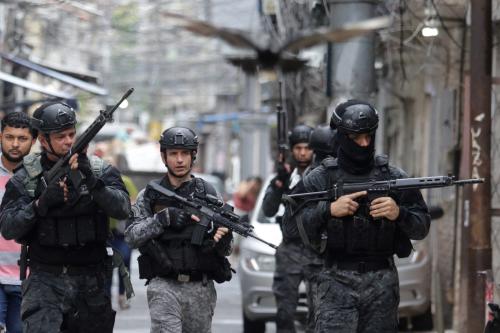
Commentary
U.S.-Cuba normalizations: A balance sheet
December 4, 2016